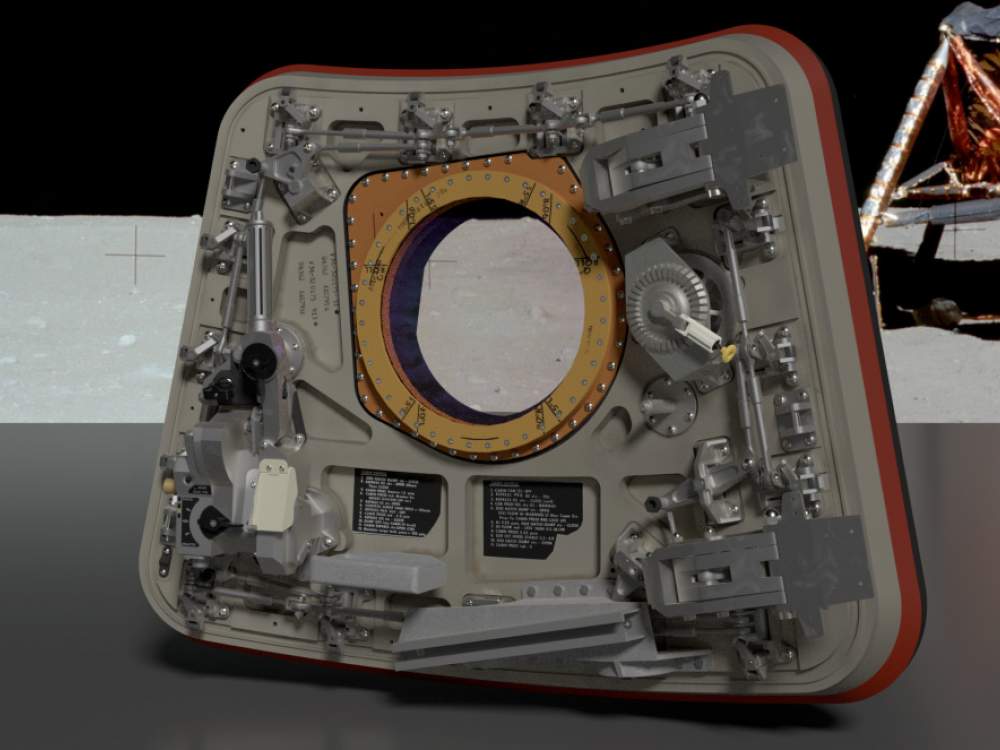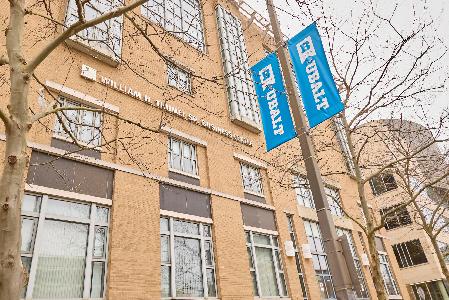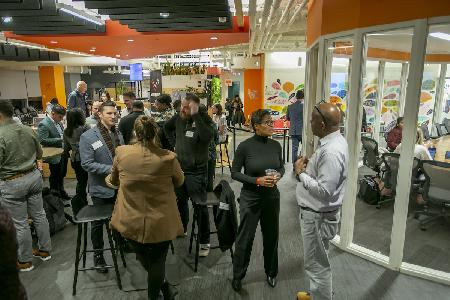Fifty years ago on Saturday, a human set foot on the moon for the first time as astronaut Neil Armstrong stepped off a spacecraft as part of the Apollo 11 mission. Even as generations pass, the event remains a milestone of scientific achievement and a cultural touchstone.
So it’s fitting that there’s all sorts of ways the event is being marked. In Baltimore, this year’s Artscape theme, “Discover,” was inspired by the feat.
Fittingly, one nearby focal point is the Smithsonian’s Air and Space Museum in D.C. That’s where Adam Savage of “Tested” and “Mythbusters” fame set out to build a life-size replica of the lunar command module’s hatch to exhibit at the museum. It’s called Project Egress.
Using 3D scans and original engineering drawings from the Smithsonian, Savage, joined by Jen Schachter and Andrew Barth, completed the build at the museum on Thursday. With such a quick turnaround, he enlisted plenty of help to get ready.
The components were fabricated by 44 different artists and fabrication shops. One latch was made by Digital Harbor Foundation (DHF) in Baltimore at the organization’s Federal Hill-based tech center that provides youth maker programming. DHF’s youth-run 3D Printshop, which is an entrepreneurial venture of DHF that undertakes 3D printing projects both for the center itself and outside clients, produced the part after receiving drawings from Savage’s team.
On Thursday, two youth, DHF Special Projects Manager Mary Reisenwitz and Tech Center Director Darius McCoy went to the build.
We had a blast building a latch for the replica Apollo 11 CM Hatch at the Air and Space Museum! Check out this picture of Adam Savage from Mythbusters adding a part 3D printed by DHF's youth-run 3D Print Shop! @donttrythis @airandspace #Apollo50 #Apollo11 pic.twitter.com/6Z8ueT1caJ
— Digital Harbor Foundation (@DHFBaltimore) July 18, 2019
Reisenwitz, who previously worked at a NASA contractor, said it was particularly inspiring to work with similar specifications to the original spacecraft. And there was a connection to current work, as 3D printing and model making is an important part of the agency’s work.
The hatch was an important feature of the spacecraft, as during a previous mission known as Apollo 1, three crew members died in a fire because they couldn’t escape. The design of the hatch that would allow for escape made for a unique challenge, as it had to be sealed properly, but allow quick opening in case it was needed.
Seeing the different parts of the door assembled was a reminder of the technological development that was part of the whole process.
“Beyond just the amazing feat of getting to space, there is a ton of technology that is created in the process of trying to get humans into space,” Reisenwitz said. And many of those tools are still being used today.
Like the moon landing itself, the anniversary is full-on media event. Here’s a look at more stories from local outlets on how the Baltimore area contributed to the original mission:
- The TV camera that beamed images of Neil Armstrong and Buzz Aldrin planting a U.S. flag on the moon into the homes of Earthlings was made at Westinghouse’s plant in Linthicum (now the site of Northrop Grumman’s operation). As Baltimore Magazine recounts, Stanley Lebar and team’s ingenuity came in creating a camera that could survive the trip.
- A team at Johns Hopkins Applied Physics Lab in Laurel was also involved in solving problems around the ability to broadcast, including reducing interference, engineer Gary Whitworth tells the JHU Hub.
- The spacesuit worn by Armstrong during his steps on the moon were made on the Eastern Shore. The Baltimore Sun revisits its 1969 coverage of ILC Industries with a photo gallery.
Before you go...
Please consider supporting Technical.ly to keep our independent journalism strong. Unlike most business-focused media outlets, we don’t have a paywall. Instead, we count on your personal and organizational support.
3 ways to support our work:- Contribute to the Journalism Fund. Charitable giving ensures our information remains free and accessible for residents to discover workforce programs and entrepreneurship pathways. This includes philanthropic grants and individual tax-deductible donations from readers like you.
- Use our Preferred Partners. Our directory of vetted providers offers high-quality recommendations for services our readers need, and each referral supports our journalism.
- Use our services. If you need entrepreneurs and tech leaders to buy your services, are seeking technologists to hire or want more professionals to know about your ecosystem, Technical.ly has the biggest and most engaged audience in the mid-Atlantic. We help companies tell their stories and answer big questions to meet and serve our community.
Join our growing Slack community
Join 5,000 tech professionals and entrepreneurs in our community Slack today!






